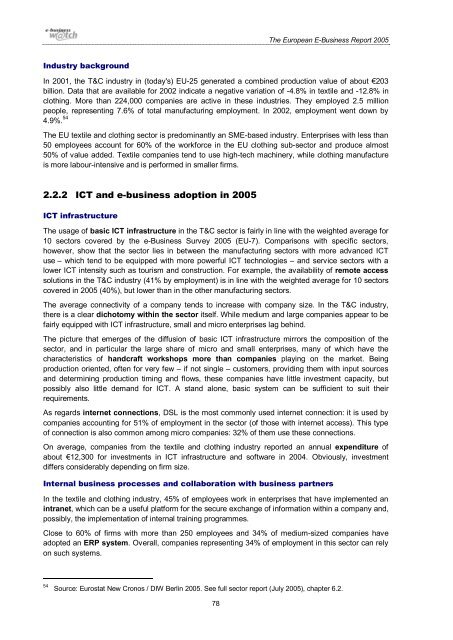The European e-Business Report The European e ... - empirica
The European e-Business Report The European e ... - empirica
The European e-Business Report The European e ... - empirica
You also want an ePaper? Increase the reach of your titles
YUMPU automatically turns print PDFs into web optimized ePapers that Google loves.
<strong>The</strong> <strong>European</strong> E-<strong>Business</strong> <strong>Report</strong> 2005<br />
Industry background<br />
In 2001, the T&C industry in (today's) EU-25 generated a combined production value of about €203<br />
billion. Data that are available for 2002 indicate a negative variation of -4.8% in textile and -12.8% in<br />
clothing. More than 224,000 companies are active in these industries. <strong>The</strong>y employed 2.5 million<br />
people, representing 7.6% of total manufacturing employment. In 2002, employment went down by<br />
4.9%. 54<br />
<strong>The</strong> EU textile and clothing sector is predominantly an SME-based industry. Enterprises with less than<br />
50 employees account for 60% of the workforce in the EU clothing sub-sector and produce almost<br />
50% of value added. Textile companies tend to use high-tech machinery, while clothing manufacture<br />
is more labour-intensive and is performed in smaller firms.<br />
2.2.2 ICT and e-business adoption in 2005<br />
ICT infrastructure<br />
<strong>The</strong> usage of basic ICT infrastructure in the T&C sector is fairly in line with the weighted average for<br />
10 sectors covered by the e-<strong>Business</strong> Survey 2005 (EU-7). Comparisons with specific sectors,<br />
however, show that the sector lies in between the manufacturing sectors with more advanced ICT<br />
use – which tend to be equipped with more powerful ICT technologies – and service sectors with a<br />
lower ICT intensity such as tourism and construction. For example, the availability of remote access<br />
solutions in the T&C industry (41% by employment) is in line with the weighted average for 10 sectors<br />
covered in 2005 (40%), but lower than in the other manufacturing sectors.<br />
<strong>The</strong> average connectivity of a company tends to increase with company size. In the T&C industry,<br />
there is a clear dichotomy within the sector itself. While medium and large companies appear to be<br />
fairly equipped with ICT infrastructure, small and micro enterprises lag behind.<br />
<strong>The</strong> picture that emerges of the diffusion of basic ICT infrastructure mirrors the composition of the<br />
sector, and in particular the large share of micro and small enterprises, many of which have the<br />
characteristics of handcraft workshops more than companies playing on the market. Being<br />
production oriented, often for very few – if not single – customers, providing them with input sources<br />
and determining production timing and flows, these companies have little investment capacity, but<br />
possibly also little demand for ICT. A stand alone, basic system can be sufficient to suit their<br />
requirements.<br />
As regards internet connections, DSL is the most commonly used internet connection: it is used by<br />
companies accounting for 51% of employment in the sector (of those with internet access). This type<br />
of connection is also common among micro companies: 32% of them use these connections.<br />
On average, companies from the textile and clothing industry reported an annual expenditure of<br />
about €12,300 for investments in ICT infrastructure and software in 2004. Obviously, investment<br />
differs considerably depending on firm size.<br />
Internal business processes and collaboration with business partners<br />
In the textile and clothing industry, 45% of employees work in enterprises that have implemented an<br />
intranet, which can be a useful platform for the secure exchange of information within a company and,<br />
possibly, the implementation of internal training programmes.<br />
Close to 60% of firms with more than 250 employees and 34% of medium-sized companies have<br />
adopted an ERP system. Overall, companies representing 34% of employment in this sector can rely<br />
on such systems.<br />
54<br />
Source: Eurostat New Cronos / DIW Berlin 2005. See full sector report (July 2005), chapter 6.2.<br />
78

















